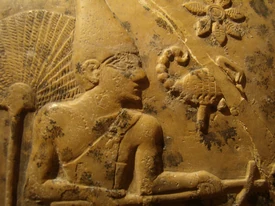
Image of King Scorpion from the Scorpion Macehead.
Scorpion, also King Scorpion or Scorpion II refers to the second of two kings so-named of Upper Egypt during the Protodynastic Period. Their names may refer to the scorpion goddess Serket. The name of the queen who was his consort was Shesh I, the mother of Narmer and the great-grandmother of another queen, Shesh II.
The only pictorial evidence of his existence is the so-called Scorpion Macehead that was found in the Main deposit by archeologists James E. Quibell and Frederick W. Green in a temple at Nekhen (Hierakonpolis) during the dig season of 1897/1898.[1] It is currently on display at the Ashmolean Museum, Oxford. The stratigraphy of this macehead was lost due to the methods of its excavators, but its style seems to date it to the very end of the Predynastic Period.[2] Though badly damaged, the visible parts are extraordinary records from this early time in Egyptian history. He is believed to have lived just before or during the rule of Narmer at Thinis for this reason, and also because of the content of the macehead.
Scorpion Macehead[]
The Scorpion Macehead depicts a single large figure wearing the White Crown of Upper Egypt. He holds a hoe, which has been interpreted as a ritual either involving the pharaoh ceremonially cutting the first furrow in the fields, or opening the dikes to flood them.[3] The name "Scorpion" is derived from the image of a scorpion that appears immediately in front of his face that may represent the scorpion goddess Serket, just below a flower with seven petals; the use and placement of the iconography is similar to the depiction of the pharaoh Narmer on the obverse side of the Narmer Palette. Protodynastic hieroglyphics are difficult to read, but the dead lapwings (meaning Lower Egyptians) and the nine bows (meaning the traditional enemies of Egyptians) found on the macehead are interpreted as evidence that he began the attacks on Lower Egypt which eventually resulted in Narmer's victory and unification of the country.[4] The lapwing was also used as a hieroglyph meaning "common people", so the standards they are attached to may represent the names of particular towns Scorpion conquered.[5]
A second, smaller macehead fragment is referred to as the Minor Scorpion Macehead.[6] Little is left of this macehead, though it clearly depicts the pharaoh wearing the Red Crown of Lower Egypt.
Theories[]
There are several theories regarding his identity. Some would argue that, because Egyptian kings of the First Dynasty seem to have had multiple names,[7] Scorpion was the same person as Narmer, simply with an alternate name. Others have identified the king Scorpion with Narmer's predecessor, Ka (or Sekhen); Edwards in 1965 considered Ka's glyph, the outstretched arms of the ka sign, as simply a stylistically different version of a scorpion.[8] The historian Susan Wise Bauer maintains that Scorpion II and Narmer were indeed two separate kings, but that Scorpion II reigned in 3200 BC, a century before Narmer.[9] Because Scorpion II is not attested at Abydos, he could be a contemporary king to Narmer, who eventually lost or bequeathed Nekhen to Narmer.
A British television programme[10] proposed that the macehead was a tribute by Narmer to King Scorpion I (whose tomb at Abydos is known). According to this theory, there was only one protodynastic king Scorpion, rather than two as is commonly maintained.
In popular culture[]
- William Golding's 1971 novella The Scorpion God is loosely based upon this period of Egyptian history.
- The Scorpion King's name was used in the 2001 film The Mummy Returns, and its spin-offs The Scorpion King (2002) and The Scorpion King 2: Rise of a Warrior (2008).
- An action-adventure video game The Scorpion King: Rise of the Akkadian was released in 2002.
- The 2007 children's novel Pharaoh by Jackie French deals with events in the court of King Scorpion, and the rivalry between his sons Narmer and Prince Hawk.
See also[]
References[]
- ↑ The Ancient Egypt Site - The Narmer Palette, accessed September 19, 2007.
- ↑ Shaw, Ian; and Nicholson, Paul. The Dictionary of Ancient Egypt. p. 254. The British Museum Press, 1995.
- ↑ Clayton, Peter A. Chronicle of the Pharaohs: The Reign-by-Reign Record of the Rulers and Dynasties of Ancient Egypt. Thames & Hudson. 2006. ISBN 0-500-28628-0
- ↑ Edwards, I.E.S., The Early Dynastic Period in Egypt. in The Cambridge Ancient History, vol. 1, part 2, ed. Edwards, I.E.S, et al. p. 6. Cambridge University Press, 1965.
- ↑ Clayton, Peter A. Chronicle of the Pharaohs: The Reign-by-Reign Record of the Rulers and Dynasties of Ancient Egypt. Thames & Hudson. 2006. ISBN 0-500-28628-0
- ↑ F. J. Yurco, "Narmer: First King of Upper and Lower Egypt. A Reconsideration of his Palette and Macehead" in Journal of the Society for the Study of Egyptian Antiquities, No. 25, 1995, Figure 1
- ↑ David P. Silverman, David O'Connor, Ancient Egyptian Kingship, Brill 1995, p.9
- ↑ Edwards, I.E.S., The Early Dynastic Period in Egypt. in The Cambridge Ancient History, vol. 1, part 2, ed. Edwards, I.E.S, et al. p. 3. Cambridge University Press, 1965.
- ↑ Susan Wise Bauer, The History Of The Ancient World (From The Earliest Accounts To The Fall Of Rome), W. W. Norton & Company, Inc., ch.4, pg.22-29
- ↑ Channel 5 TV programme Secrets of Egypt 2/8 Scorpion King, 8pm to 9pm Thu 20 November 2008
| This page uses content from the English Wikipedia. The original article was at King Scorpion. The list of authors can be seen in the page history. |